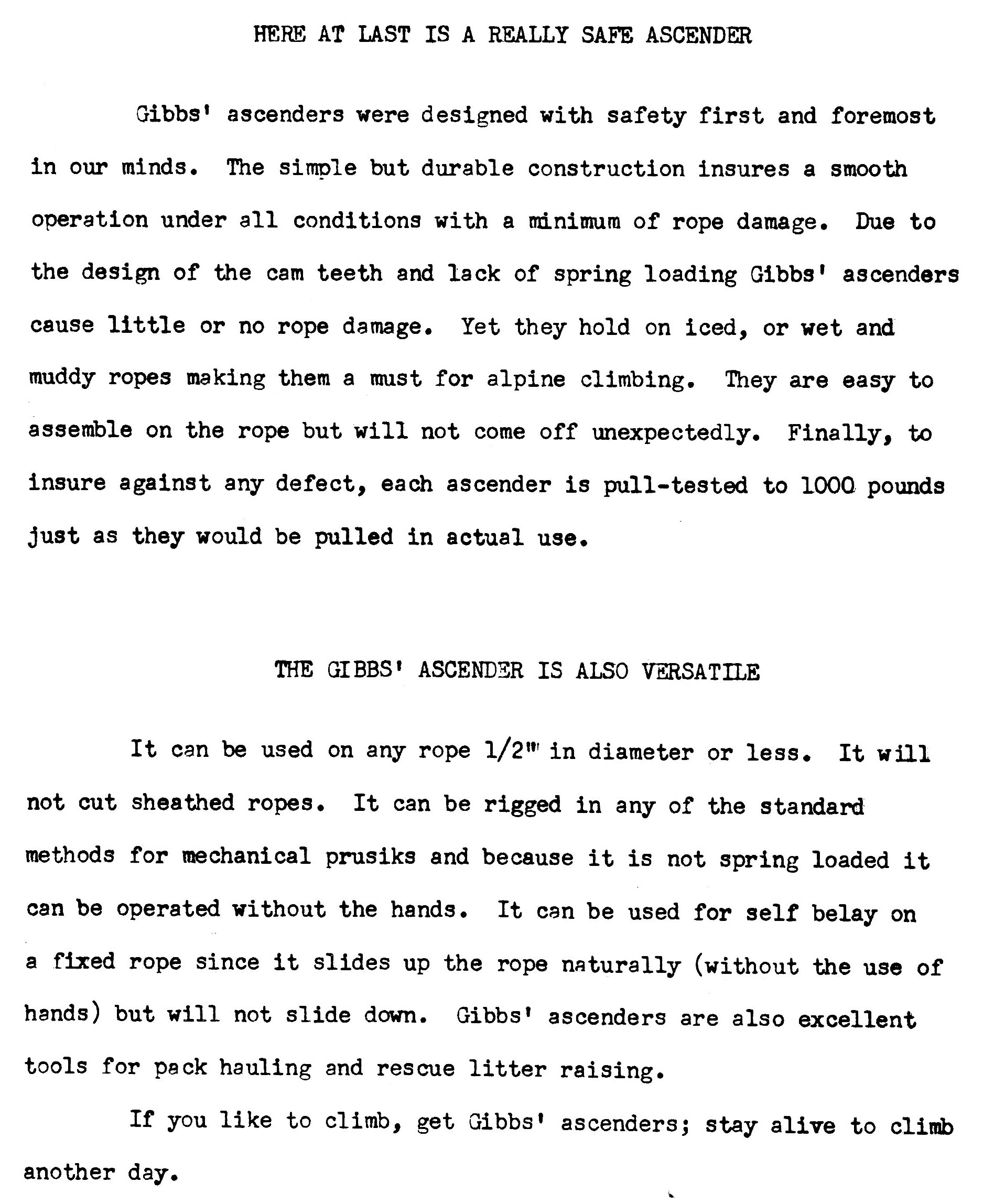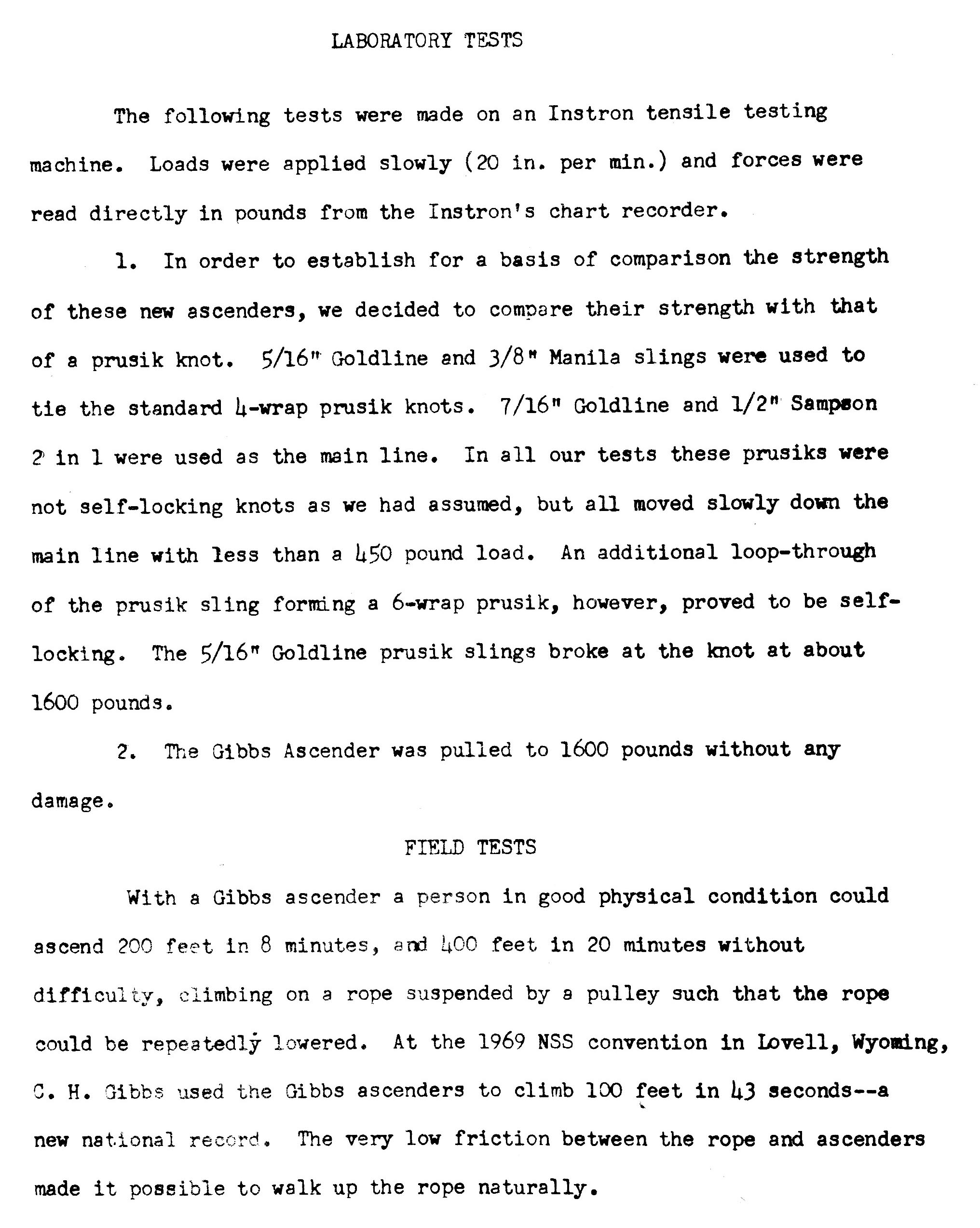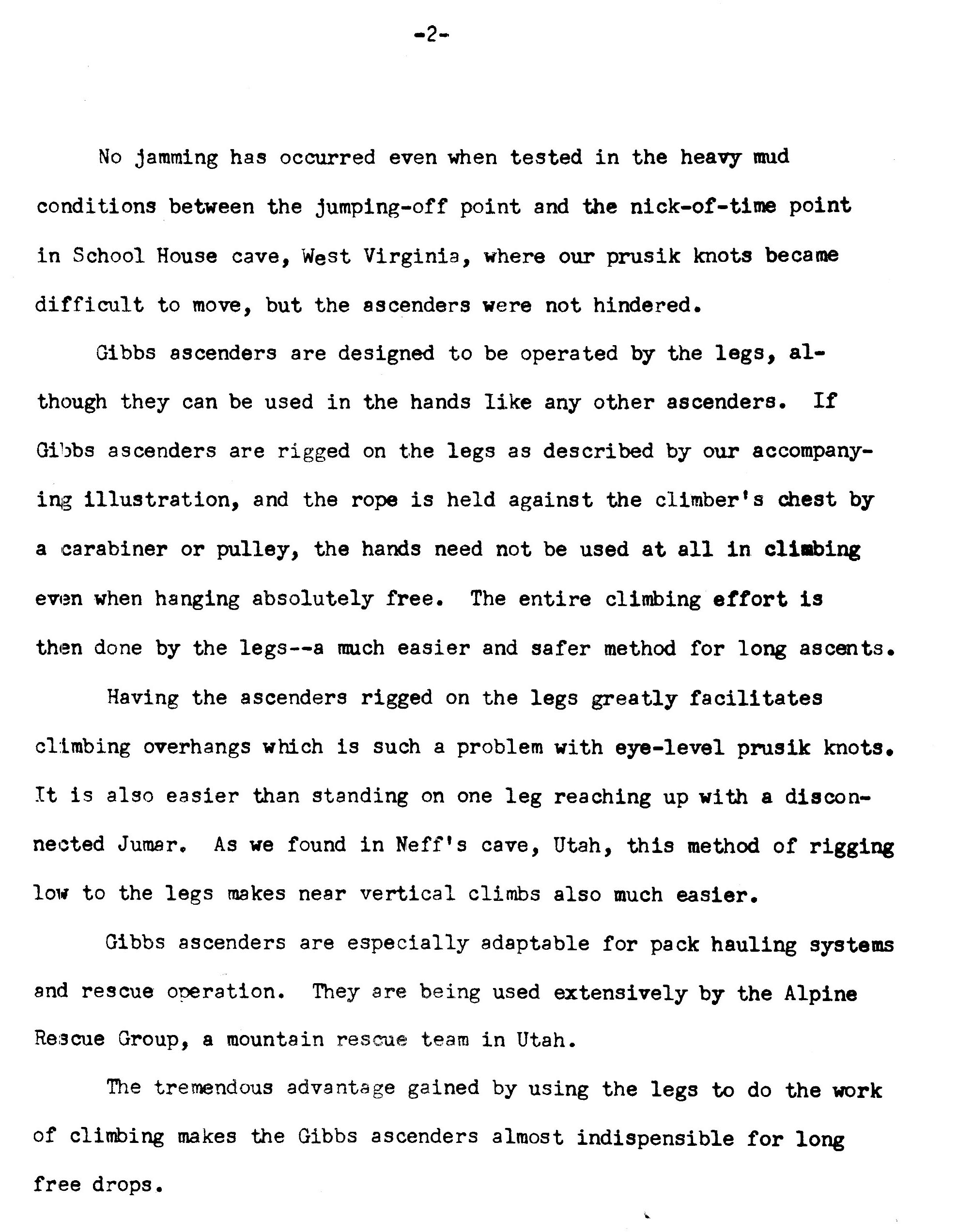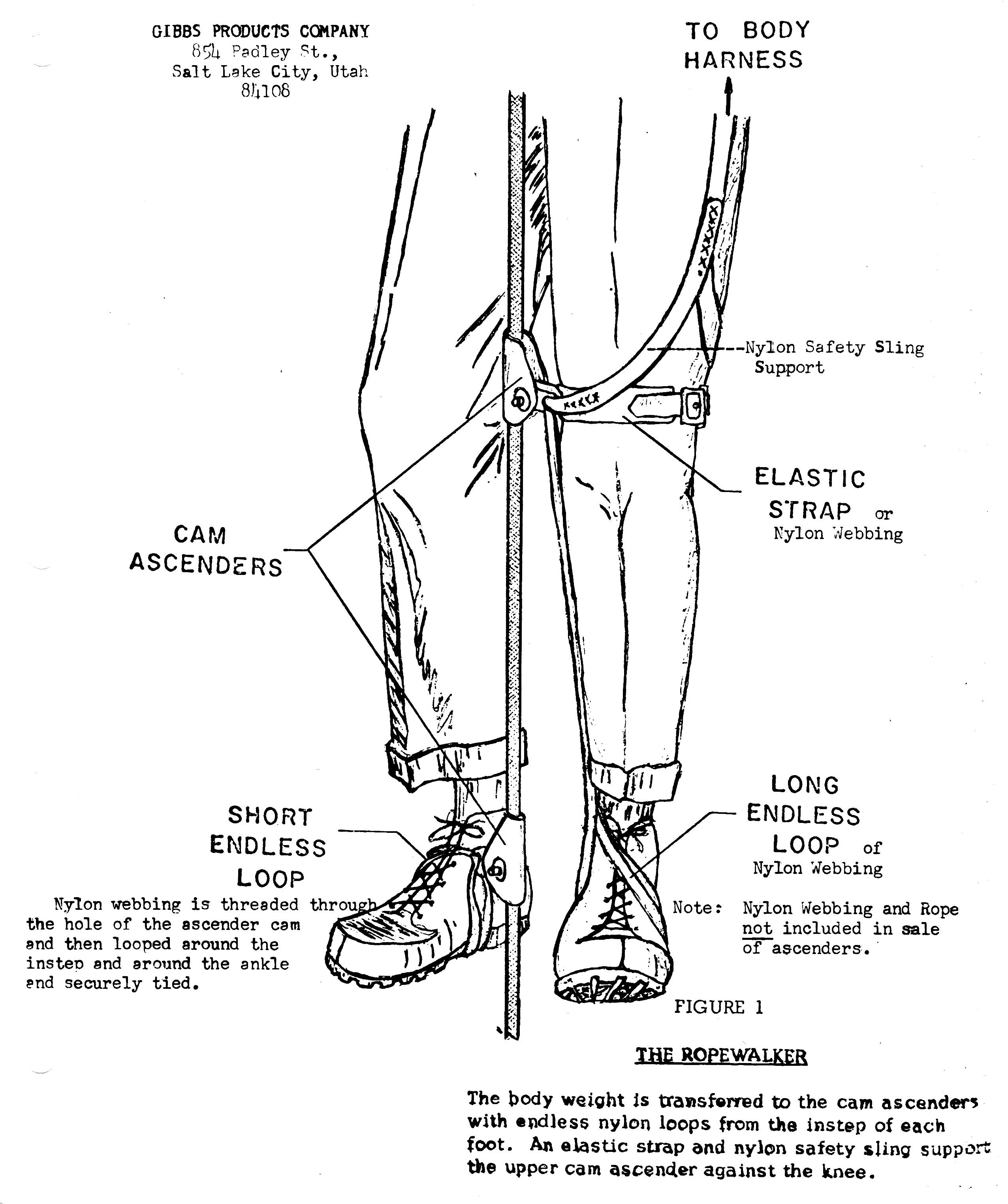Overview
The earliest Gibbs were spring-wire models. Here is a quick summary of the versions in my collection (all have aluminum shells):
- Crude sand cast 11-tooth cam, plastic retainers
(#128)
- Spring-wire retainer with plastic crimp cover
(#2393)
- Eliminated plastic crimp cover
(#61,3645)
- New cam pin
(#252, 2248)
- New 9-tooth cam with narrow rib
(#1521, 1977)
- Wide rib cam, cord cam keeper.
(#62, 1978, 2343, 3436, 3499, 3616)
- Anodized shell.
(3550)
- New rib-less 9-tooth cam, cam keeper glued into hole in top of cam.
(#63, 1548, 2244, 2394)
[ Top
| Version B
| Version C
| Version D
| Version E
| Version F
| Version G
| Version H
| Return to L.C. Ascenders
]
Version A1 & A2
(#128)
Technical Details
I acquired a pair of Gibbs Spring-wire, Version A ascenders at the NSS Auction
in 1998.
Version A is 103 mm. tall, 64 mm. wide, 36 mm. thick, and
weighs 148 g. The shell is bent from
1/8 in aluminum to form a U-shaped groove. The cam is cast aluminum.
It has 11 teeth, and is tapered near the tip, something some copies
have failed to do. The cam rides on a steel pin axle that is drilled
at the end to accept a retainer. The retainers on this Gibbs are
0.1 inch nylon line. The same material is used as a pin keeper.
Subversion A1 has no markings. Subversion A2 has "GIBBS PROD." stamped once on the front of the shell and twice on the back.
Gibbs ascenders were the premier ascender for long free-hanging
ascents, and are still a good option when rigged properly. This one is one of the first 50 made. This basic design has lasted
for decades, almost without change.
[ Top
| Version A
| Version C
| Version D
| Version E
| Version F
| Version G
| Version H
| Return to L.C. Ascenders
]
Version B
(#2393)
Technical Details
I acquired my Gibbs Spring-wire, Version B from Rick Banning at the 2019 NSS Convention.
Version B is 103 mm.
tall, 63 mm.
wide, 36 mm.
thick, and weighs 154 g.
The rope channel is 17 mm.
wide. The cam radius increases from 19 to 34 mm. over an angle of 93°, giving a 20° cam angle. The retainers on this Gibbs are
2.4 mm. spring-wires. The same material is used as a pin keeper.
Version B has a sticker saying "TESTED TO 1000 LBS." Rich stamped his last name on the shell.
Rick attached a tag to this ascender with the following note:
"Early Gibbs 1 May 19
somewhat cruder cam teeth
Rick Banning"
[ Top
| Version A
| Version B
| Version E
| Version F
| Version G
| Version H
| Return to L.C. Ascenders
]
Version C
(#61, 3645)
Technical Details
I acquired my first Gibbs Spring-wire, Version C sometime in
the 1980s, but I don't have any records of the acquisition. I acquired a pristine pair from Collectibles from Maine / John Freund in 2024.
Version C is 103 mm. tall, 64 mm. wide, 36 mm. thick,
and weighs 152 g. This ascender uses the same cam, shell and pin as Version A,
but the nylon retainer and pin keeper have been replaced with
a spring wire (much like a thicker guitar string).
Both sides of the shell are stamped "GIBBS PROD."
The spring-wire is a significant improvement over the nylon retainer.
[ Top
| Version A
| Version B
| Version E
| Version F
| Version G
| Version H
| Return to L.C. Ascenders
]
Version D
(#252, 2248)
Technical Details
I acquired my first Gibbs Spring-wire, Version D from Bill Boehle at the 2008 Old
Timers Reunion. I acquired two more in 2017 as part of Bob Thrun’s collection.
Version E is 103 mm. tall, 59 mm. wide, 36 mm. thick, and weighs 150 g. The rope channel is 17 mm. wide. The cam radius increases from 16 to 32 mm. over an angle of 88°, giving a 25° cam angle.
This ascender uses the same cam, shell, and spring-wires. as Version C,
but the cam pin has been changed. The spring-wire is now crimped into a hole drilled in the shaft, below the head, rather than a groove in the head.
Both sides of the shell are stamped "GIBBS PROD."
The new method of attaching the spring-wire is more secure than the old one was.
[ Top
| Version A
| Version B
| Version C
| Version D
| Version F
| Version G
| Version H
| Return to L.C. Ascenders
]
Version E
(#1521, 1977)
Technical Details
I acquired a Gibbs Spring-wire, Version E ascenders from Myra Nicholas in 2009 and a second from David Jones in 2014, both in used condition.
Version E is 103 mm. tall, 59 mm. wide, 36 mm. thick, and weighs 150 g. Version E features a new the cam design. The number of teeth
was reduced to 9. The upper part of the cam was reshaped to give
a distinct rib.
Both sides of the shell are stamped "GIBBS PROD."
The new cam performs better than the original. The rib is for aesthetic reasons, and serves no utilitarian
function. The new cam was dubbed the "racing cam."
[ Top
| Version A
| Version B
| Version C
| Version D
| Version E
| Version G
| Version H
| Return to L.C. Ascenders
]
Version F
(#62, 1978, 2343, 3436, 3499, 3616)
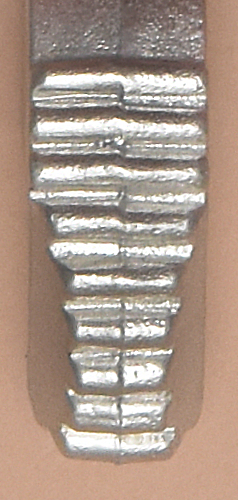 Technical Details
Technical Details
I acquired a Gibbs Spring-wire, Version F ascender from John E. Weinel,
Inc. in 1989. I got a second one used on eBay from David Jones in 2014, two more in new condition from Bill Liebman at the 2017 Old Timers Reunion, and one from William Shrewsbury in 2021. I then received another pair in new condition, complete with original paperwork, from Michael S. McBride in 2022. Kim Fleischmann gave me another at the 2023 NSS Convention.
Version F is 104 mm. tall, 59 mm. wide, 37 mm. thick,
and weighs 155 g. This version adds another terminal crimp for attaching a keeper cord. Unlike later designs, the cord is tied to the cam eye instead of being directly attached to the cam. The rib on the top of the cam is wider as well, 9 mm. instead of 5 mm. on the previous version.
Both sides of the shell are stamped "GIBBS PROD."
The photo is of one that I obtained from Michael S. McBride. The black cord keeper is original, but I had to tie it myself. I used the full length, although I would cut it in practice. All others of this version came with a red cord that matches the cord used on the following version. The second one in my collection has the crimp but is missing the cord. The "new" ones acquired from Bill came with cords, but it was left to the buyer to tie the cords to the cams.
[ Top
| Version A
| Version B
| Version C
| Version D
| Version E
| Version F
| Version H
| Return to L.C. Ascenders
]
Version G
(#3550)
Technical Details
I acquired two Gibbs Spring-wire, Version G ascenders from Kelley Deem at the 2022 Old Timers Reunion.
Version F is 103 mm. tall, 59 71. wide, 37 36. thick,
and weighs 154 g. This version adds another terminal crimp for attaching a keeper cord. Unlike later designs, the cord is tied to the cam eye instead of being directly attached to the cam. The rib on the top of the cam is 8 mm. wide.
Both sides of the shell are stamped "GIBBS PROD."
This version introduces the gold-colored anodized shell. Barry Chute owned these before Kelley, and scratched his name on the side and spine of the shells. Any keeper cords that may have been supplied with these ascenders were lost by the previous owners.
[ Top
| Version A
| Version B
| Version C
| Version D
| Version E
| Version F
| Version G
| Return to L.C. Ascenders
]
Version H
(#63, 1548, 2244, 2394)
Technical Details
I acquired three Gibbs Spring-wire, Version H ascenders from Gibbs Products
Inc. in 1973, and three more from J. W. Jackson in 2011. I acquired another in 2017 as part of Bob Thrun’s collection, and one from Rich Banning at the 2019 NSS Convention.
Version H is 104 mm. tall, 59 mm. wide, 36 mm. thick
and weighs about 182 g. Version H introduced yet another cam design, also with 9 teeth.
The rib was eliminated. A hole was drilled in the top and side
of the cam, and a keeper cord was glued in place. The shell is
anodized.
Both sides of the shell are stamped "GIBBS" with a double underline.
I have two minor variations of this version, one with the cam
keeper cord attached to the left side of the shell and one to
the right.
[ Top
| Version A
| Version B
| Version C
| Version D
| Version E
| Version F
| Version G
| Version H
]



